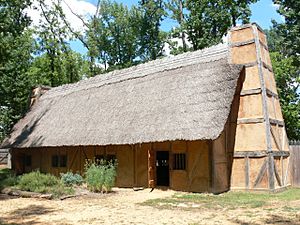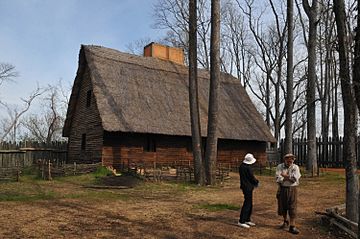Henricus facts for kids
Quick facts for kids
Henricus
Henricopolis, Henrie Town, Henrico
|
|
|---|---|
|
Town
|
|

Reconstruction of Mt. Malady, the first English hospital in America
|
|
| Present Country | United States of America |
| State | Virginia |
| Established | 1611 |
| Abandoned | by 1622 |
| Founded by | Thomas Dale |
| Named for | Prince Henry |
|
Henrico
|
|
| Lua error in Module:Location_map at line 420: attempt to index field 'wikibase' (a nil value). | |
| Nearest city | Dutch Gap, Chesterfield County, Virginia |
| Area | 12 acres (4.9 ha) |
| Built | 1611 |
| NRHP reference No. | 72001400 |
| Significant dates | |
| Added to NRHP | April 13, 1972 |
The "Citie of Henricus"—also known as Henricopolis, Henrico Town or Henrico—was a settlement in Virginia founded by Sir Thomas Dale in 1611 as an alternative to the swampy and dangerous area around the original English settlement at Jamestown, Virginia. Named for Henry, Prince of Wales (1594–1612), the eldest son of King James I, Henricus is located on a former curl of the James River about 12 miles southeast of the modern city of Richmond, Virginia or 15 miles from the fall line of the James River.
Today, the settlement is interpreted via Henricus Historical Park, a living history museum. It is surrounded by the Dutch Gap Conservation Area, an 810 acre mixture of woodlands and wetlands operated by Chesterfield County, Virginia. Captain Dale (who had previously served as a mercenary with Dutch forces) ordered a channel dug which attempted to shorten the river meander, hence the name Dutch Gap. As discussed below, the channel was re-dug during the American Civil War, which created Farrar's Island, which after further dredging became the main course of the James River around 1870. The park and conservation area are on the Captain John Smith Chesapeake National Historic Trail.
History
The second successful English colonial settlement in the New World, Henricus was opposite to the Native American village of Arrohateck. At the time, the First Anglo-Powhatan War was raging, and the Indian tribes of Virginia offered continuous resistance to colonial settlement, largely orchestrated by native leader Nemattanew — or as the colonists knew him, "Jack-of-the-Feather". Before the development of Richmond, Henricus was one of the westernmost outlying developments from the Colony of Virginia's fortified capital downriver at Jamestown. In 1612–1613, a facility known as "Mt. Malady" was built nearby; it was the first hospital in the English colonies of North America.
This settlement was near where Pocahontas grew up among the Appomattoc tribe of the Powhatan Confederacy. Reverend Alexander Whitaker converted her to Christianity during her captivity at Henricus under Sir Thomas Dale, deputy governor of the colony. She met colonist John Rolfe during this time and they married on April 5, 1614. Rolfe's longtime friend, Richard Buck, presided at their wedding. They lived together across the river at the Varina Farms Plantation. Their mixed-race son, Thomas Rolfe (named for Sir Thomas Dale, deputy governor of the colony of Virginia), was born on the plantation. His descendants were among many of the First Families of Virginia (FFV).
Proposed college at Henricus
The Virginia Company tried to found the first institution of higher education in British America. In 1618, they obtained a royal charter from King James I of England for a proposed University of Henrico. In 1619, the historic First Virginia General Assembly met at Jamestown and passed their 5th Petition: "Send men to erect the Colledge", referred to it as "A worke of Conversion", and set aside land for it adjacent to and above Henricus. In 1619, Henricus was also incorporated into the City of Henrico. The fort was abandoned by governor's orders during the Indian massacre of 1622, and largely destroyed by the Powhatan afterwards.
By 1623, more settlers occupied the college land than before the massacre. The next year James I dissolved the Virginia Company, seizing its assets and transforming the proprietary colony into a royal one. The Crown controlled it from then on.
End of colonial era
Henricus became part of the Shire of Henrico (created 1634) and was renamed Henrico County in 1637. Virginia Company stockholder William Farrar acquired the property in 1637 and his descendants sold it to Thomas Randolph in 1737. Meanwhile, in 1693, the College of William and Mary was established in Williamsburg under a new charter granted by the joint English monarchs King William III and Queen Mary II. A plaque on the Wren Building, the college's first structure, ascribes the institution's origin to "the college proposed at Henrico".
Modern era
The area later saw action during the American Revolutionary War. During the American Civil War, it played a minor role in the Bermuda Hundred Campaign and in 1865 the Battle of Trent's Reach, one of the last major naval engagement of the conflict, was fought offshore. In the interim, Union General Benjamin Butler ordered troops to excavate the narrow neck of Farrar's Island on which Henricus was located to create the Dutch Gap Canal in an attempt to bypass Confederate defensive batteries along the James River. The channel was widened in 1870, and became the main channel of the James River, and the old river channel silted up, forming what is now the 810-acre (3.3 km2) Dutch Gap Conservation Area.
In 1922, Chesterfield County annexed the former location of Henricus south of the Dutch Gap Canal from Henrico County.
The area became used for sand and gravel mining, and sunken ships are still visible in the lagoon. Dominion Power still operates Chesterfield Power Station, with controversial coal ash lagoons adjoining the Dutch Gap Conservation area.
Over time, the exact location of the former town of Henricus became uncertain. After archealogical excavations, the U.S. National Register of Historic Places in 1972 listed the 12-acre (4.9 ha) archeological site in Chesterfield County as Henrico. Though archaeological evidence of the actual settlement has not been found (due to the creation of Dutch Gap and other disturbances including the nearby quarries), a reconstruction based on historical evidence of the settlement was created nearby as a living history museum, Henricus Historical Park.


